United Kingdom
Studley Royal Park
Studley Royal Park including the Ruins of Fountains Abbey is a human-made landscape around the combination of a medieval monastery and an 18th-century water garden.
They were brought together by William Aislabie in 1767 when he added the neighbouring ruins to his family estate. Fountains Abbey had been the largest and wealthiest in England until the Dissolution of the Monasteries. Landscape features such as Studley Royal Water Garden (an outstanding example of the ‘English’ garden style), the deer park and the Victorian Gothic St. Mary's Church were added later.
Community Perspective: You have to pay to enter the formal gardens and abbey, however, all are free to walk through the Deer Park and visit the impressive neo-Gothic St Mary's church. The Abbey ruins are still in good shape and at their most picturesque from the view from Anne Boleyn’s Seat.
Site Info
Official Information
- Full Name
- Studley Royal Park including the Ruins of Fountains Abbey (ID: 372)
- Country
- United Kingdom
- Status
-
Inscribed 1986
Site history
History of Studley Royal Park
- 1986: Inscribed
- Inscribed
- Type
- Cultural
- Criteria
- i
- iv
Links
- UNESCO
- whc.unesco.org
- Official
-
- fountainsabbey.org.uk — fountainsabbey.org.uk
- Related
-
- en.wikipedia.org — William Burges, architect of St. Mary's Church
All Links
UNESCO.org
- whc.unesco.org — whc.unesco.org/
Official Website
- fountainsabbey.org.uk — fountainsabbey.org.uk
Related Resources
- en.wikipedia.org — William Burges, architect of St. Mary's Church
News Article
- Aug. 14, 2025 bbc.com — Managing drought challenge at Studley
- Feb. 19, 2025 yorkmix.com — Fountains Abbey targeted by vandals
- Feb. 4, 2025 bbc.com — Fountains Abbey improvements to go ahead
- Aug. 4, 2023 building.co.uk — Plans unveiled to refresh ruined abbey
- Oct. 25, 2021 theguardian.com — Archaeologists find ‘missing link’ in history of Fountains Abbey
- Nov. 15, 2016 theguardian.com — Fountains Abbey study reveals scale of monks burial site
- Sept. 21, 2016 darlingtonandstocktontimes.co.uk — "Marble" statues get a makeover at Studley
Community Information
- Community Category
- Secular structure: Park or garden
Travel Information
Recent Connections
-
Significant Follies
"When the socially ambitious John Aisla…
-
Perfect Inscriptions
1986 -
Horse Stables
"The Palladian Studley Royal House was …
Connections of Studley Royal Park
- Individual People
-
-
Works by David Hockney
"Ian. Fountains Abbey" 1983See www.kwiatart.com
-
Painted by JMW Turner
Several e.g "The Dormitory and Transept of Fountains Abbey - Evening" 1798
-
- Architecture
-
-
Gothic Revival
One of the follies in the park is a neo-Gothic castle -
Palladio and Palladian style
One of the follies in the park is palladian style banqueting house -
English garden
-
Domes
St. Mary's Church has an inner dome -
Mosaic art
On the floor of St. Mary's Church -
Octagons
Octagon Tower -
Wooden architecture
Temple of Fame: "The temple of Fame is a folly in both senses of the word as it appears to be made from stone, but is in fact painted wood." -
Neoclassical architecture
Temple of Piety -
Georgian Architecture
Banqueting House
-
- World Heritage Process
-
-
Perfect Inscriptions
1986
-
- Religion and Belief
-
-
Cistercian
-
Benedictines
The Fountains Abbey was founded in 1132 by thirteen Benedictine monks (wiki)
-
- Constructions
-
-
Tunnels
Serpentine Tunnel -
Obelisk
Studley Obelisk : "The obelisk at the south western end of Studley Park was erected in 1815 as an 'eyecatcher' at one end of the formal avenue." -
Sphinx
-
Canals
The River Skell was straightened out into a canal -
Latrines
Fountains Abbey The "Reredorter" -
Clock Tower
"Studley Royal House has distinct pavilion towers in all four corners surrounding a central courtyard and working clock tower." -
Horse Stables
"The Palladian Studley Royal House was originally the stables for the Aislabie family's mansion on the Studley Royal estate near Ripon." -
Significant Follies
"When the socially ambitious John Aislabie inherited Studley Royal, he set about creating an elegant water garden of mirror-like ponds, statues and follies, incorporating the romantic ruins into his design." (About Fountains Abbey etc)
-
Purpose Built Visitor Centre
In Core Zone 1992
-
- WHS on Other Lists
- Timeline
-
-
Built in the 18th century
Studley Royal Park: Between 1718 and the end of the century John and William Aislabie created "what is arguably England's most important 18th century Water Garden." (Wiki) The 16th century house, rebuilt in Palladian, style was burnt down in 1946 leaving just the gardens -
Built in the 12th century
Fountains Abbey - Founded 1132 "its construction lasted from 12th to 16th century"
-
- WHS Hotspots
News
- bbc.com 08/14/2025
- Managing drought challenge at Stud…
- yorkmix.com 02/19/2025
- Fountains Abbey targeted by vandals
- bbc.com 02/04/2025
- Fountains Abbey improvements to go…
Recent Visitors
Visitors of Studley Royal Park
- Adam Hancock
- Adrian Turtschi
- Alexander Barabanov
- Alexander Lehmann
- Alex Goh
- alicemears
- A. Mehmet Haksever
- Anna Wludarska
- Argo
- Atila Ege
- BaziFettehenne
- BenReeve
- Birgitte Sørensen
- c82wc1
- CampbellME
- Caspar
- CherylKla
- ChrisN
- Christer Sundberg
- Christravelblog
- Claire Bradshaw
- ClaraHH
- Clyde
- Colossus
- Csaba Nováczky
- Daniel Chazad
- Dimitar Krastev
- Dorejd
- Doubanjiang
- Dr. Caligari
- edstar500
- Els Slots
- Erik Jelinek
- Errol Neo
- Eva Kisgyorgy
- Fam39
- Fan Yibo
- Farinelli
- Feldhase
- Femke Roos
- Filip Murlak
- forest80
- Frederik Dawson
- FS
- gautamiyer23
- Geert Luiken
- George Gdanski
- Gernot
- Grendel Gongan
- Grzegorz Andruszkiewicz
- Harry Mitsidis
- Hubert
- Iain Jackson
- Ian Cade
- Ivan Rucek
- Jakob F.
- James Bowyer
- James F
- janem
- Janina Lehmann
- Jarek Pokrzywnicki
- Jay T
- Jeanne OGrady
- Jezza
- João Aender
- Joebobs
- Joel on the Road
- Jonas Kremer
- Klaus Freisinger
- Lado Joel
- Lara Adler
- leckie118
- Linz
- Luis Filipe Gaspar
- Luj3904
- Lukasz Palczewski
- Maciej Gil
- Marlies van Wolfswinkel
- Martina Rúčková
- Matthewsharris
- MH
- Mikko
- Milan Jirasek
- MMM
- Naim Y
- nan
- Neil McPaul
- Nicole Lampos
- Nihal Ege
- PabloNorte
- Patrik
- Paul Schofield
- Peter Lööv
- Petteri
- Philipp Leu
- Philipp Peterer
- Piotr Wasil
- Potsdamer
- Ralf Regele
- Randi Thomsen
- Roger Ourset
- Roman Bruehwiler
- Rudegirl
- Sabrina Liebehentschel
- Samy G
- Schnitzel
- SDMArado
- Sergio Arjona
- Shandos Cleaver
- Simonf
- Solivagant
- Squiffy
- Ssong.x
- Stanislaw Warwas
- Stijn
- Svein Elias
- Szucs Tamas
- Tamara Ratz
- Taotao Chen
- Tevity
- Thomas Buechler
- Thomas Harold Watson
- Thomas van der Walt
- Tom Flaten
- Tsunami
- usagi1974
- ValiaVeweth
- Viaje al Patrimonio
- V&M
- Walter
- Wojciech Fedoruk
- Wo_ko
- Zach
- Zoë Sheng
Community Reviews
Show full reviews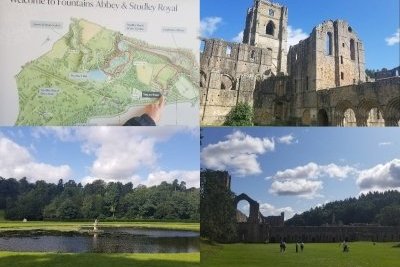
Some of our community members pride themselves with reviewing EVERY site they visit and I think for the UK there is no reason to do so, and in fact I'm not sure I want to review any of them unless I ever make it those uninhabited islands in the middle of nowhere...though I now pride myself with having reviewed ONE of the country's site (Bermuda is still an easy candidate that hasn't been added recently and IF you count it as being park of the UKas it is actually British overseas territory) and with Studley Royal Park it's also been years since the last review. Well, not that this place changes in ANY way.
The park itself is huge. It should be a day trip for the paid entrance alone. Not many people went to the free areas surrounding it. When visiting (or regularly?) they also had a sort of discovery game for kids which pleased the two young visitors that tagged along with me and made visiting every corner of the map worth it for them. The main interest of the visit should be Fountains Abbey which is grande and takes about half an hour by itself. The Gothic St. Mary's Church is much smaller and is more of a museum, and the rest is mainly just open garden areas. The strolls along the river and the lake are beautiful in summer and was totally worth the entrance ticket alone. We also arrived early in the morning and …
Keep reading 0 comments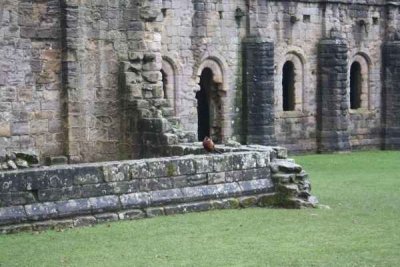
March 2018 - After our visit in Durham we came here to Studley. The visitor center is very nice and modern.
After the rain paused for a bit wen walked through the park. A lot of pheasants walked around and made it an interesting experience. After a short walk we reached the ruin. It is the heart of the park and way older than the park itself. However it is not a ruin, but was never finished, at least thats what we learned in a documentary about Studley. The rest of the park is not that spectacular, but certainly a good example for English Garden Architecture.
Keep reading 0 comments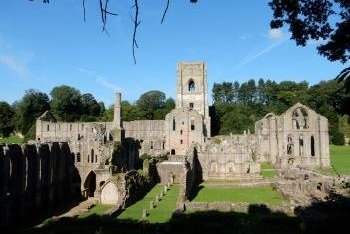
This is a site I went to with rather low expectations, but which turned out to be very interesting - and the fact that I visited on a gloriously warm and sunny September day certainly helped. The huge ruins of Fountains Abbey (not all ruins, many elements are still standing) are really amazing, and give you a great picture of monastic life in the Middle Ages. You can walk among them for hours, and the abbey is probably one of the best monastic/religious sites I have seen so far. Once you have satisified your curiosity with the ruins, a pleasant walk takes you through the Studley Royal Water Garden, which was created around the ruins in the 18th century. I always wondered about the odd combination of a 12th-century monastery with a formal Baroque garden, but they fit together well and form a coherent whole. All in all, I had a great day there - just one advice if you plan to arrive by public transport: there are only a handful of buses every day (line 139 from Ripon), and only on 3 days a week, so careful planning is necessary. I went on a Saturday (taking a train from Leeds to Harrogate and continuing by bus to Ripon) and it worked out fine.
Keep reading 0 comments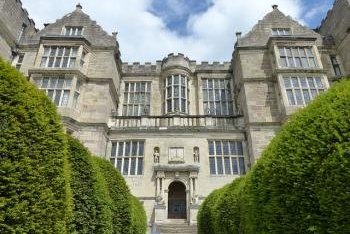
I visited this WHS in June 2016. Getting there by car from Saltaire, I drove through some narrow rural roads and I could already appreciate the green surrounding landscape. Once you get close to the car parks, the first thing you see is a huge green board stating that this site is a WHS and apparently it is the only 'official' board which states so. There's no plaque even though this site was inscribed in 1986 together with another 6 WHS in the UK. The car park is free but entrance to the Studley Royal Park costs 13 pounds! The map given when you buy the entrance ticket is very good and clearly indicates the loop to follow. A few steps after leaving the visitor centre and just after Swanley Grange, there is the first important crossroad. Although you might be tempted to go straight to the Fountains Abbey ruins which are visible from this crossroad, if you want to visit everything head towards the opposite direction towards Fountains Hall and Fountains Mill as the trail will then follow the same trail to the Abbey. As part of Studley Royal Park's 30th anniversary as a WHS, in June 2016 there was a small exhibition in Fountains Hall (picture) on this WHS and on world heritage in general. The highlights of this WHS are the Cistercian ruins, St Mary's Church interior and the surprise view. To be honest, I failed to see any OUV in this WHS and it's more of …
Keep reading 0 comments
Before visiting a new WHS, I always read the AB evaluation to see if there are any specifics about the site that you would not gather from a “normal” guide. Although Studley’s nomination in 1986 wasn’t that early in the process, it was among the first batch of UK sites. The country actually nominated only Fountain’s Abbey and St. Mary’s Church, which ICOMOS found an odd combination to have with two buildings from totally different eras. They responded with a conditional inscription, suggesting that the 18th-century landscape gardens should be included. The result is that the focus of the WHS has shifted from the two monuments to the park, with a totally different OUV.
So now it’s a park that we visit, a huge English landscape garden with some French touches. I was the first to enter on the day and wasn’t bothered by any crowds that would show up later in the day. I followed the main walk that is described in the site’s brochure, which takes you from the Abbey along the Canal to the Water Garden and Lake. It ends at St. Mary’s Church and Deer Park. When you end up on one side of the canal, it’s quite a walk to backtrack to see something on the other side (and that’s how I missed Fountains Mill).
What I did see though was the view from Anne Boleyn’s Seat – probably the most iconic vista of Studley, as also shown by most of the reviewers …
Keep reading 0 comments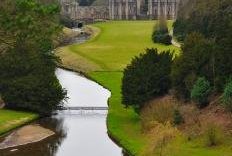
From the beautiful spa town of Harrogate, after having a nice breakfast at the famous Betty's Tea Room, I took a conveniently bus line 36 to the city of Ripon to visit the famous Royal Studley Park, a World Heritage Site and reportedly one of the best sites to visit in the historical Yorkshire. Instead of walking to the park from Ripon like many tourists, I decided to take an alternative route by starting my walk from Lead Lane which is located along the bus route before Ripon. From Lead Lane I walked thru residential zone until I reached a small river and crossed the bridge, after crisscrossing the farm along the trekking route I finally reached the gate of the Deer Park.
The famed Royal Studley Park could easily be divided into 3 areas, Deer Park, Water Gardens and Ruins of Fountain Abbey. In Deer Park, the park landscape was a mix of light forest and English Garden, the centerpiece of the area was the Gothic St Mary Church and its straight road that cut the park into two and made a visual link between the church and Ripon Cathedral, a really nice landscape design that rarely fine in England. The park was said to have deer, but I could not find anyone of them. After Deer Park I continued south to the Water Gardens, it was here where I have to pay entry ticket. The garden was quite a popular place for tourists, I made a visit …
Keep reading 0 comments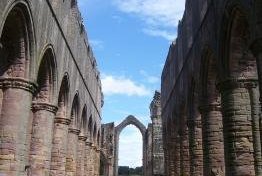
This was a great place to spend a leisurely afternoon and was one of the more impressive WHS I have visited in England. The planned gardens were particularly impressive especially the highly formal water garden. Many of the gardens I have visited in the UK have a folly as their focal point, however here the huge remains of Fountains Abbey provide a much better focus. The view from Anne Boleyn's chair is magnificent and shows the best aspects of this planned landscape. I was actually surprised by how extensive the ruins of the abbey were, I was expecting a small church and maybe a few crumbling walls. However the ruins were very large reflecting the fact that this was one of England's largest abbeys.
You have to pay to enter the formal gardens and abbey, however all are free to walk through the Deer Park and visit the impressive neo-Gothic St Mary's church, both of there are really great additions to the world heritage site.
The site is located just outside of Ripon in north Yorkshire. If you don't have your own transport then there are regular buses on Sunday's and few infrequent ones the rest of the week. I unfortunately missed one of the few busses on the Saturday that I visited. However I had half expected this and was prepared for the pleasant 5km walk from the town centre to the start of the gardens proper. It was nice to get into the countryside, and although it wasn't …
Keep reading 0 comments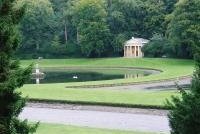
To get to Fountains Abbey I took a #36 bus from Harrogate to Ripon from where there was a #139 minibus that took me to the visitor centre inside the park. From there it was a short distance to the ruins of Fountains Abbey, which are quite extensive and take some time to explore.
From the abbey I contined through the Studley Royal water garden, past temples, lakes and follies to the deer park. Later I returned to the visitor centre by way of St Mary's church to catch the minibus back to Ripon.
Keep reading 0 comments
